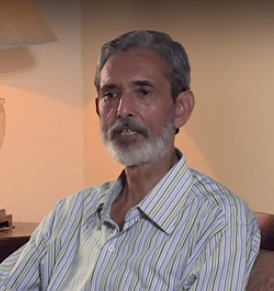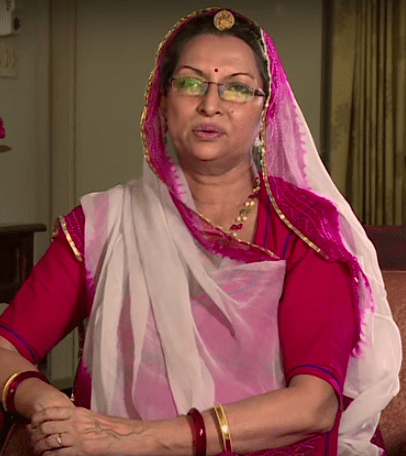Lesson plan developed for http://hindistartalk.lrc.columbia.edu/ by Rosanne Zeppieri and Rajni Bhargava; language notes by Rakesh Ranjan.
 Theme/ Topic: Meeting the Family — Based on
Theme/ Topic: Meeting the Family — Based on
http://hindistartalk.lrc.columbia.edu/lesson/rathore-family-introduction/
Targeted Performance Level: Intermediate Low/Mid
Age Range of Learners: 15-21 years
Time: 90 minutes
Objectives: Students will be able to:
- Understand the main idea and details presented in a short video clip about family members.
- Initiate a conversation about family.
- Exchange information, details, and explanations during a conversation.
- Bring a conversation to a close.
- Interview a prospective mate.
- Talk about my daily routine.
- Talk about my interests and hobbies.
- Provide reasons for my preferences.
- Explain a decision and give detailed reasons to support my point of view.
Language Targets:
Descriptions of family members and their relationships:
- maataa (f)- mother — pitaa (m)- father
- naanaa (m) -maternal grandfather — naanii (f) -maternal grandmother
- daadaa (m)- paternal grandfather — daadii (f) – paternal grandmother
- beTaa (m) – son — beTii (f) – daughter
- bhaaii (m)- brother — bhaabhii (f) – brother’s wife
- bahan (f)- sister — jiijaa (m) – sister’s brother
- chaachaa (m)- uncle (father’s brother) — chaachii (f) – uncle’s wife
- maamaa (m)- mother’s brother — maamii (f) – maamaa’s wife
- mausii (f)-mother’s sister — mausaa(m) – husband of mausii
- sasur (m)- father-in-law — saas (f) – mother-in-law
Biographical information (age, place of birth, educational background.)
- aapkaa/tumhaaraa naam kyaa hai?
- meraa naam … hai
- meraa imel hai…
- mera pataa hai…
- Where are you from? Where do you live? · aap kahaaN rahte /rahti haI? · tum kahaaN rahte/rahtii ho? · aap kahaaN se haiN?
- maiN …se huuN. · maiN … meN rahtaa/rahtii huuN.
- vah kis raajya/desh meN hai.
- NYC/LA/Chicago/Beijing se kitnii duur hai?
- tum kitne saal ke/kii ho? · aapkii umr kya hai?
- saal kaa/kii huuN. · Merii umr … sal kii hai.
- aapkaa/tumhaaraa janmdin/saalgirah kab hai? Aap apnaa janmdin/saalgirah kab manaate/manaatii haiN?
- maiN … ko paidaa huaa thaa. · aur aap/tum?
- aap mujhse baRe/baRii haiN · aap chhoTe/chhoTii haiN · tum mujhse bare/baRii/ ho · tum chhoTe/chhoTii ho
- tumhaare bhaai aur bahan haiN? · tumhaare kitne bhaaii aur bahan haiN?
- haaN, mera 1 bhaaii/mere 2 bhaaii haiN · merii 1 bahan/2 bahaneN haiN
- nahiiN, maiN akelaa huuN · maiN eklautaa bachhaa huuN
- tumhaare kitne bhaaii/bahan haiN?
- kyaa aap sabse bare/baRii haiN? · aap sabse chhote/chhoTii haiN? · kyaa tum sabse baRe/baRii ho? · aap sabse chhote/chhoTii haiN?
Professions:
- teacher – shikShak (m/f)

- student – chhaatra (m)chhatraa (f)
- principal – prachaarya (m/f)
- custodian – sanrakShak (m/f)
- mayor – mahaapaur (m/f)
- engineer – abhiyantaa (m/f)
- doctor – chikitsak (m/f)
- nurse – nars (m/f)
- police officer – pulis adhikaarii (m/f)
- firefighter – fairfaiTar (m/f)
- soldier – sainik (m/f)/faujii (m/f)
Interests and hobbies:
- X khelnaa
- saikil chalaanaa
- viDio gem khelnaa
- Tiivii dekhanaa
- kitaabeN/pustakeN paRhnaa
- filmeN dekhanaa
- dostoN ke sath ghuumne jaanaa
- mall meN dostoN se milnaa
- to shop – kharidaarii karnaa
- to swim – tairnaa
- sangiit sunna
- piano, violin, sitar bajaanaa
Expressions of opinion:
- mere anubhav meN…
- merii raai meN…
- meraa sujhaaw haiN kI…
- maiN vishvaas kartaa/kartii huuN ki….
- meraa matlab hai ki…
Complex sentence structures:
A relative clause is a subordinate clause which generally modifies a noun or a noun phrase and it is introduced by a relative pronoun. In Hindi ‘jo’ is a direct relative pronoun and jis/jin+postpostion is an oblique form. For example:
vah laRkaa meraa dost hai jo lambaa hai – that boy who is tall is my friend.
vah laRkii jisne saaRii pahnii hai merii bahan hai- that girl who has worn a sari sister.
Information questions:
For nouns and pronouns:
- kyaa- what ( for inanimate nouns). For example: yah kyaa hai? yah kitaab hai. (What is this? This is a book)
- kaun- who (for animate nouns). For example: vah kaun hai? vah Rita hai. (Who is she? She is Rita.)
For adjectives: kaisaa/kaise/kaisii- how (for adjectives- quality). For example:
- mausam kaisaa hai? mausam achhaa hai.
- laRke kaise haiN? LaRke hoshiyaar hai.
- kitaab kaisii hai? kittab mahaNgii hai.
- kitnaa/kitne/kitnii- how much/how many.
For example:
- kitnaa paani?- how much water?
- kitne laRke?- how many boys?
- Kitnii laRkiyaaN?- ho wmany girls?
For adverbs:
- kahaaN
- kab
- kyoN
- kaise
- kidhar
Narration in the present tense:
The present Habitual construction usually indicates regular, frequent activities in Hindi. It is also used to express narrative constructions in the present tense. The habitual aspect of the verb is formed by adding the right suffix –taa or –te or –tii to the verb stem. The appropriate present tense form of honaa is used the mark the tense.
For example: Mohan roz subah vidyalaay jataa hai. vahaaN vah paRtaa aur likhtaa hai. vah dostoN ke saath bateN kartaa hai aur unke saath kelataa hai.
Performance Assessment:
As they prepare for the marriage of their son/daughter, a father and mother view video clips and consult marriage websites for potential mates for their son /daughter. Once they choose a family who appears to be compatible with their own family, they visit the home of that family to decide if the match is viable or not. The prospective bride and groom have a chance to talk with one another and become acquainted as the other family members do the same. After returning home the family discusses in detail what they have learned. The son/daughter disagrees with the family’s decision. A debate ensues until the family is able to negotiate a final outcome.
Learning Scenarios:
Opening Activity: The teacher sets the context for the lesson asking students to complete a “quick write” as they respond the question of whether they would accept an arranged marriage or not. If yes, they must give at least three reasons; if no, they must support their choice with specific reasons.
Activity 2: Teacher divides students into small groups to share their ideas about arranged marriages and to decide on the top reasons for and against such marriages. Next students mingle and find classmates who share their ideas. They form groups. The teacher leads an oral debriefing asking for input from the different groups in the room.
Activity 3: To prepare for the family meeting, students brainstorm questions they might ask of the potential mate and of their family members. They compile the questions on a large poster to use as reference during the lesson.
Activity 4: Students practice asking and answering the questions they created using an Inside/Outside Circle format. This allows all students to gain familiarity with new vocabulary and structures.
Activity 5: Individually, students prepare an introduction of their family. This introduction may be an email, a video, a slideshow, or other media of their choice. They post their work around the classroom and then circulate to read and comment on one another’s introductions.
Activity 6: Students form “family groups” to role play the scenario of meeting the family of a prospective mate.
Activity 7: Students record or write a response to the following questions, “If and when you have children, would you accept their Time: 15 decision to marry
Links:
http://hindistartalk.lrc.columbia.edu/lesson/rathore-family-introduction/ Hindi Module- Rathore Family,
an Introduction Websites for finding potential mates – http://classifieds.jagran.com/matrimony
http://classifieds.jagran.com/matrimony/grooms
http://epaper.patrika.com/714444/Rajasthan-Patrika-Jaipur/07-02-2016#page/15/2å